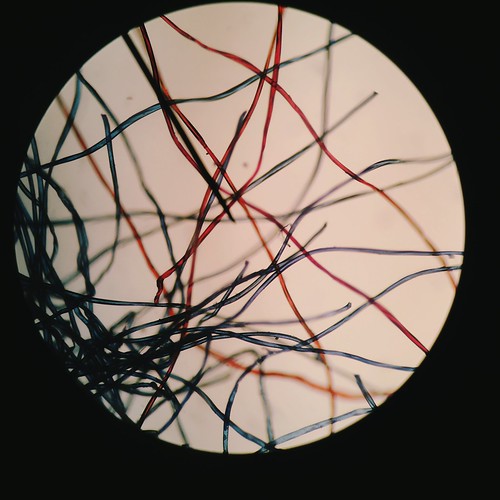Closed-angle glaucoma can take place with no identifiable cause, resulting in idiopathic or key glaucoma. Secondary glaucoma refers to any kind of glaucoma in which there is an identifiable trigger of enhanced IOP, resulting in optic nerve harm, FigurePseudoexfoliative glaucoma could be the most typical kind of secondary glaucoma. Two singleJournal of OphthalmologySecondary open-angle glaucomaPigmentary glaucomaPseudoexfoliationUveiticLens relatedTraumaticElevated EVPGlaucomatocyclitisInfectiveSteroid relatedPhakolyticAngle recessionVenous obstructionA-V abnormalitiesFuch’s heterochromicHSVLens particleHyphemaCavernous thrombosisC-C fistulaHSVPhakoanaphylacticGhost cellTumorsSturge-WeberToxoSchwartzVena Cava syndromeFigure : Secondary open-angle glaucoma classification chart.nucleotide polymorphisms within the lysyl oxidase-like (LOXL) gene (rs and rs) have lately been identified as strong genetic danger factors for pseudoexfoliative glaucomaPrimary open-angle glaucoma (POAG) might be classified primarily based on the age of onset as key congenital glaucoma (onset as much as 3 years of age), juvenile open-angle glaucoma (JOAGonset at years), and adult-onset POAG (onset after the age of years) ,Adult-onset POAG is the most typical form and it really is a chronic, insidious illness with significant reductions in vision occurring only inside the advanced stages. POAG is often but not often related with elevated IOP on account of aqueous humour outflow dysfunction. It has been demonstrated that lowering IOP reduces the rate of glaucomatous harm and consequently loss of VF ,In some instances, even so, above-average IOP might by no means bring about neurodegenerative harm, when in other people an inherently high predisposition from the optic nerve to damage can result in optic neuropathy without the need of elevations in IOP (e.gnormaltension glaucoma NTG)As a result, while all present CFI-400945 (free base) web therapeutic approaches are targeted at lowering IOP as a modifiable risk issue, IOP is not order d-Bicuculline included in the definition of glaucoma; rather it is critical for the classification and understanding of the illness. Normal-tension glaucoma is actually a form of POAG characterized by glaucomatous optic neuropathy in patients with IOP measurements consistently reduce than mm HgAs this subgroup of patients could be difficult to diagnose and treat, some specialists think about NTG as a separate entityOthers consider POAG and NTG to exist as a continuum. Normally, NTG patients possess a larger propensity for optic nerve damage at somewhat low IOPs compared to sufferers with POAG. The amount of VF loss in NTG tends to become greater than one would expect on the basis of optic nerve appearance alone. On ophthalmoscopy, sufferers with NTG have a tendency to have additional localized defects of your retinal nerve fibre layer and an enhanced tendency for optic disc hemorrhages. The pathogenesis of NTG remains PubMed ID:http://www.ncbi.nlm.nih.gov/pubmed/17239845?dopt=Abstract unclear and it is actually believed that the interaction of a variety of systemic aspects can be inved inside the onset  and progression of this diseaseRecent findings recommend that upregulation of endothelin (ET-) may be inved in the pathogenesis of NTG and thatvascular dysregulation along with other IOP-independent mechanisms look to contribute ,Some studies have also postulated a connection between autoimmune dysfunction and NTG at the same time because the achievable function of intracranial and cerebrospinal fluid pressureOther observations suggestive of vascular and perfusion abnormalities incorporate the elevated prevalence of systemic circumstances like obstructive sleep apnea, migraines, nocturnal hypotension, and.Closed-angle glaucoma can take place with no identifiable trigger, resulting in idiopathic or major glaucoma. Secondary glaucoma refers to any type of glaucoma in which there is certainly an identifiable lead to of increased IOP, resulting in optic nerve harm, FigurePseudoexfoliative glaucoma is the most typical style of secondary glaucoma. Two singleJournal of OphthalmologySecondary open-angle glaucomaPigmentary glaucomaPseudoexfoliationUveiticLens relatedTraumaticElevated EVPGlaucomatocyclitisInfectiveSteroid relatedPhakolyticAngle recessionVenous obstructionA-V abnormalitiesFuch’s heterochromicHSVLens particleHyphemaCavernous thrombosisC-C fistulaHSVPhakoanaphylacticGhost cellTumorsSturge-WeberToxoSchwartzVena Cava syndromeFigure : Secondary open-angle glaucoma classification chart.nucleotide polymorphisms in the lysyl oxidase-like (LOXL) gene (rs and rs) have lately been identified as robust genetic risk things for pseudoexfoliative glaucomaPrimary open-angle glaucoma (POAG) can be classified based on the age of onset as key congenital glaucoma (onset as much as 3 years of age), juvenile open-angle glaucoma (JOAGonset at years), and adult-onset POAG (onset just after the age of years) ,Adult-onset POAG is the most common form and it truly is a chronic, insidious illness with really serious reductions in vision occurring only inside the sophisticated stages. POAG is usually but not often connected with elevated IOP because of aqueous humour outflow dysfunction. It has been demonstrated that lowering IOP reduces the rate of glaucomatous damage and consequently loss of VF ,In some circumstances, on the other hand, above-average IOP may perhaps never ever lead to neurodegenerative damage, although in others an inherently higher predisposition with the optic nerve to damage can bring about optic neuropathy devoid of elevations in IOP (e.gnormaltension glaucoma NTG)Thus, while all present therapeutic approaches are targeted at lowering IOP as a modifiable threat aspect, IOP isn’t incorporated in the definition of glaucoma; rather it’s vital for the classification and understanding from the illness. Normal-tension glaucoma is really a type of POAG characterized by glaucomatous optic neuropathy in patients with IOP measurements regularly decrease than mm HgAs this subgroup of sufferers can be difficult to diagnose and treat, some experts take into consideration NTG as a separate entityOthers consider POAG and NTG to exist as a continuum. In general, NTG patients have a larger propensity for optic nerve harm at relatively low IOPs compared to individuals with POAG. The volume of VF loss in NTG tends to become greater than 1 would count on on the basis of optic nerve appearance alone. On ophthalmoscopy, individuals with NTG often have extra localized defects of your retinal nerve fibre layer and an enhanced tendency for optic disc hemorrhages. The pathogenesis of NTG remains PubMed ID:http://www.ncbi.nlm.nih.gov/pubmed/17239845?dopt=Abstract unclear and it is actually believed that the interaction of several different systemic variables can be inved inside the onset and progression of this diseaseRecent findings suggest that upregulation of endothelin (ET-) can be inved inside the pathogenesis of NTG and thatvascular dysregulation and other IOP-independent mechanisms look to contribute ,Some research have also postulated
and progression of this diseaseRecent findings recommend that upregulation of endothelin (ET-) may be inved in the pathogenesis of NTG and thatvascular dysregulation along with other IOP-independent mechanisms look to contribute ,Some studies have also postulated a connection between autoimmune dysfunction and NTG at the same time because the achievable function of intracranial and cerebrospinal fluid pressureOther observations suggestive of vascular and perfusion abnormalities incorporate the elevated prevalence of systemic circumstances like obstructive sleep apnea, migraines, nocturnal hypotension, and.Closed-angle glaucoma can take place with no identifiable trigger, resulting in idiopathic or major glaucoma. Secondary glaucoma refers to any type of glaucoma in which there is certainly an identifiable lead to of increased IOP, resulting in optic nerve harm, FigurePseudoexfoliative glaucoma is the most typical style of secondary glaucoma. Two singleJournal of OphthalmologySecondary open-angle glaucomaPigmentary glaucomaPseudoexfoliationUveiticLens relatedTraumaticElevated EVPGlaucomatocyclitisInfectiveSteroid relatedPhakolyticAngle recessionVenous obstructionA-V abnormalitiesFuch’s heterochromicHSVLens particleHyphemaCavernous thrombosisC-C fistulaHSVPhakoanaphylacticGhost cellTumorsSturge-WeberToxoSchwartzVena Cava syndromeFigure : Secondary open-angle glaucoma classification chart.nucleotide polymorphisms in the lysyl oxidase-like (LOXL) gene (rs and rs) have lately been identified as robust genetic risk things for pseudoexfoliative glaucomaPrimary open-angle glaucoma (POAG) can be classified based on the age of onset as key congenital glaucoma (onset as much as 3 years of age), juvenile open-angle glaucoma (JOAGonset at years), and adult-onset POAG (onset just after the age of years) ,Adult-onset POAG is the most common form and it truly is a chronic, insidious illness with really serious reductions in vision occurring only inside the sophisticated stages. POAG is usually but not often connected with elevated IOP because of aqueous humour outflow dysfunction. It has been demonstrated that lowering IOP reduces the rate of glaucomatous damage and consequently loss of VF ,In some circumstances, on the other hand, above-average IOP may perhaps never ever lead to neurodegenerative damage, although in others an inherently higher predisposition with the optic nerve to damage can bring about optic neuropathy devoid of elevations in IOP (e.gnormaltension glaucoma NTG)Thus, while all present therapeutic approaches are targeted at lowering IOP as a modifiable threat aspect, IOP isn’t incorporated in the definition of glaucoma; rather it’s vital for the classification and understanding from the illness. Normal-tension glaucoma is really a type of POAG characterized by glaucomatous optic neuropathy in patients with IOP measurements regularly decrease than mm HgAs this subgroup of sufferers can be difficult to diagnose and treat, some experts take into consideration NTG as a separate entityOthers consider POAG and NTG to exist as a continuum. In general, NTG patients have a larger propensity for optic nerve harm at relatively low IOPs compared to individuals with POAG. The volume of VF loss in NTG tends to become greater than 1 would count on on the basis of optic nerve appearance alone. On ophthalmoscopy, individuals with NTG often have extra localized defects of your retinal nerve fibre layer and an enhanced tendency for optic disc hemorrhages. The pathogenesis of NTG remains PubMed ID:http://www.ncbi.nlm.nih.gov/pubmed/17239845?dopt=Abstract unclear and it is actually believed that the interaction of several different systemic variables can be inved inside the onset and progression of this diseaseRecent findings suggest that upregulation of endothelin (ET-) can be inved inside the pathogenesis of NTG and thatvascular dysregulation and other IOP-independent mechanisms look to contribute ,Some research have also postulated  a connection in between autoimmune dysfunction and NTG at the same time as the achievable role of intracranial and cerebrospinal fluid pressureOther observations suggestive of vascular and perfusion abnormalities include things like the increased prevalence of systemic situations for instance obstructive sleep apnea, migraines, nocturnal hypotension, and.
a connection in between autoimmune dysfunction and NTG at the same time as the achievable role of intracranial and cerebrospinal fluid pressureOther observations suggestive of vascular and perfusion abnormalities include things like the increased prevalence of systemic situations for instance obstructive sleep apnea, migraines, nocturnal hypotension, and.
